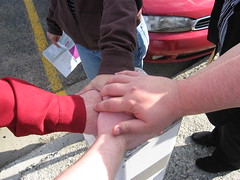
Speaker: Robert McDonald, Indiana University
Never use a fad term for your talk because it will make you look bad ten years later.
We’re not so tied up into having to build hardware stacks anymore. Now, that infrastructure is available through other services.
[insert trip down memory lane of the social media and mobile phones of 2005-2006]
We need to rethink how we procure IT in the library. We need better ways of thinking this out before committing to something that you may not be able to get out of it. Market shifts happen.
Server interfaces are much more user friendly now, particularly when you’re using something like AWS. However, bandwidth is still a big cost. Similar infrastructures, though, can mean better sharing of tools and services across institutions.
How much does your library invest in IT? How much of your percentage of your overall budget is that? How do you count that number? How much do we invest on open source or collaborative ventures that involve IT?
Groups have a negativity bias, which can have an impact on meetings. The outcomes need to be positive in order to move an organization forward.
Villanova opted to spend their funds on a locally developed discovery layer (VUFind), rather than dropping that and more on a commercial product. The broader community has benefitted from it as well.
Kuali OLE has received funding and support from a lot of institutions. GOKb is a sister project to develop a better knowledgebase to manage electronic resources, partnering with NCSU and their expertise on building an ERMS.
[Some stuff about HathiTrust, which is a members-only club my institution is not a part of, so I kind of tuned out.]
Something something Hydra and Avalon media system and Sufia.
Forking of open projects means that no one else can really use it, and that the local institution is on its own for maintaining it.
In summary, consider if you can spend money on investing in these kinds of projects rather than buying existing vendor products.



